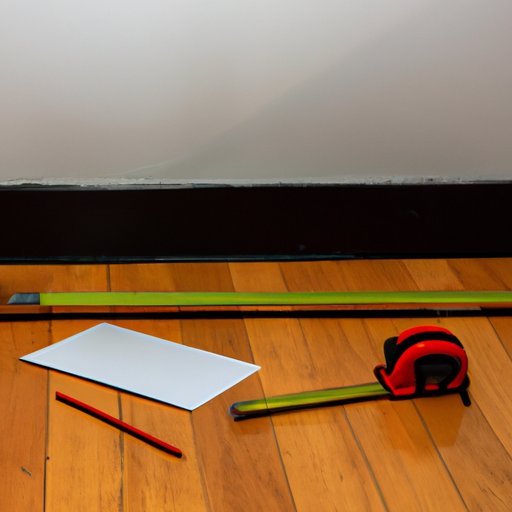I. Introduction
Have you ever wondered what square footage means? It’s simply the measure of area in square feet of a given surface. This is especially important for home renovation projects where accurate measurements are critical for determining the materials required and the cost of the project. In this article, we explore how to determine square feet and why it is important.
II. Step-by-Step Guide on How to Measure Square Footage
The first step in determining square footage is to figure out the shape of the surface that needs to be measured. Whether it’s a rectangular, circular, or triangular surface, the process of measuring square footage is simple.
To measure square footage for a rectangular surface, simply measure the length and width of the area using a measuring tape. Multiply these two measurements to get the total square footage of the surface. For example, a room that is 10 feet long and 8 feet wide has a total area of 80 square feet (10 x 8).
To measure square footage for a circular surface, measure the diameter of the surface, which is the distance from one end of the circle to the other. Then, divide this measurement by 2 to get the radius of the circle. From there, use the following formula: square footage = π x radius^2. Here, π is a constant value of approximately 3.14.
To measure square footage for a triangular surface, measure the base and height of the triangle, then multiply the two measurements and divide by 2 to get the total square footage of the surface.
Tip: Always double check your calculations to avoid any mistakes that could compromise accuracy.
III. The Importance of Determining Square Footage
Determining the square footage of an area is crucial when planning a renovation project. Accurate measurements ensure that the right amount of materials needed to complete the project are purchased, reducing the risk of waste and financial loss. Additionally, different spaces may have different methods of calculation, and precision is crucial to ensure the safety and functionality of the final product.
Accuracy in determining square footage is especially important in determining factors such as wall paint and flooring coverage. Failure to measure accurately could lead to under or over-estimation of the materials to purchase, leading to increased costs or wasted resources.
IV. Comparison of Different Methods of Measuring Square Footage
There are various methods of measuring square footage. One of the most popular options is to use an online calculator that takes in the dimensions and calculates the square footage for you. While this method is fast and easy, it may not be as accurate as other methods.
The traditional way of measuring square footage is through the use of a measuring tape. While this method is cheap, it can be time-consuming and requires patience and skill to ensure an accurate measurement.
Advanced techniques such as laser measuring tools are also available. These tools are mostly used in commercial applications, and their accuracy might not be necessary for home renovation projects.
When it comes to choosing the most suitable method for measuring square footage, consider factors such as the type of surface and the size of the area. For small areas, a measuring tape can be useful, while for larger areas, online calculators may be a more efficient option.
V. Real-Life Case Study on Measuring Square Footage for a Specific Room
To put the above methods into practice, let’s take the example of a room with several irregular surfaces. To measure the square footage, divide the room into different sections, and measure each section separately, taking the measurements with as much precision as possible, and then adding up the measurements.
During the measurement process, you may face challenges such as obstacles in the way. For example, when measuring around windows, measure the area up to the borders, and then subtract the area of the window to get a more accurate measurement.
One of the good practices when measuring room square footage is moving in an anti-clockwise direction while measuring the length, then the breadth, and subtracting the space occupied by irregular shapes such as windows and doors.
VI. Tools Needed to Determine Square Footage
When measuring square footage, you will need various measuring tools such as the measuring tape, a ruler, a protractor, and a laser measuring tool (for more advanced measurement). The cost of these tools varies depending on the brand and the features they come with. Basic tools can be found in most hardware stores and are affordable for home renovation projects.
It’s also important to ensure that each tool is working accurately and avoid errors arising from malfunctioning devices. Practice using each tool beforehand to ensure that accurate measurements are taken.
VII. Conclusion
To sum up, measuring square footage is essential, especially for home renovation projects. By following these tips and methods, you can ensure accuracy in determining the square footage of the surface you want to renovate or decorate. The choice of which measuring tool to use depends on factors such as the size of the surface, the accuracy required, and costs involved. Ultimately, always aim for the highest accuracy when measuring to avoid costly errors and make informed decisions when planning projects.
